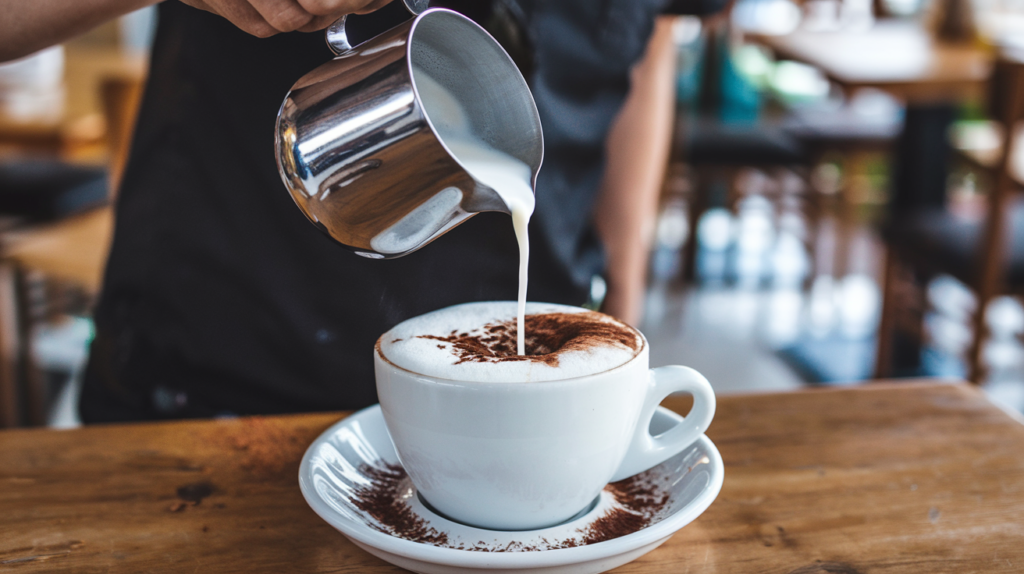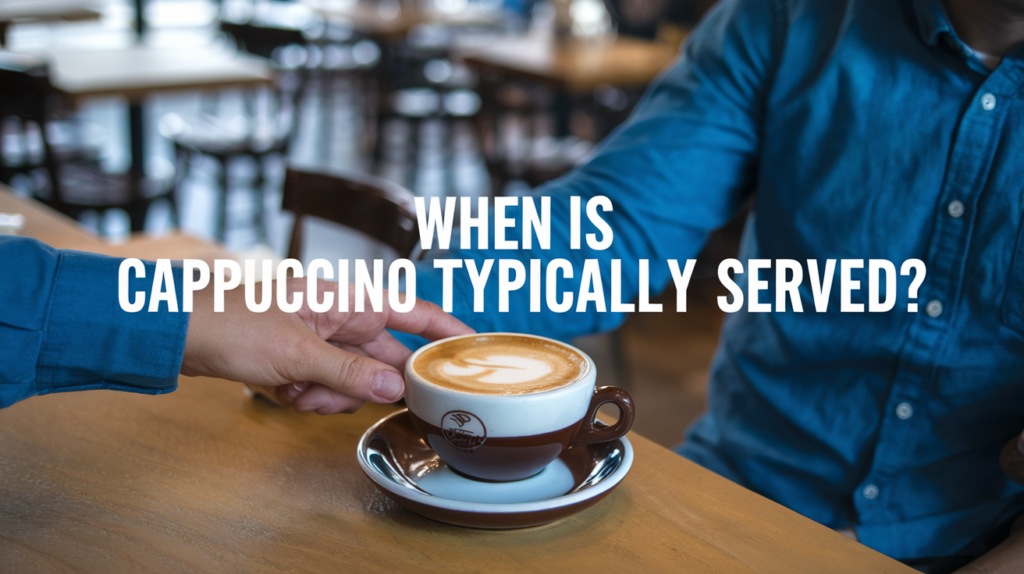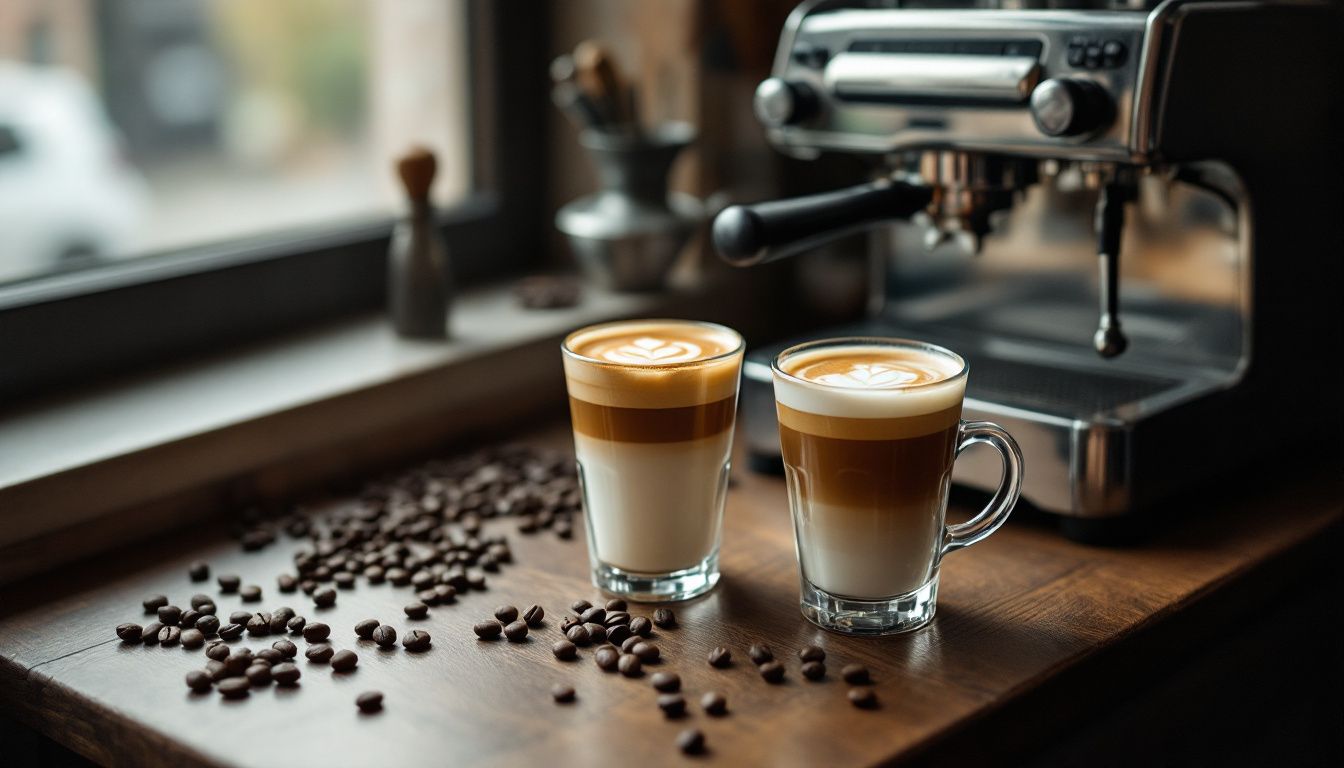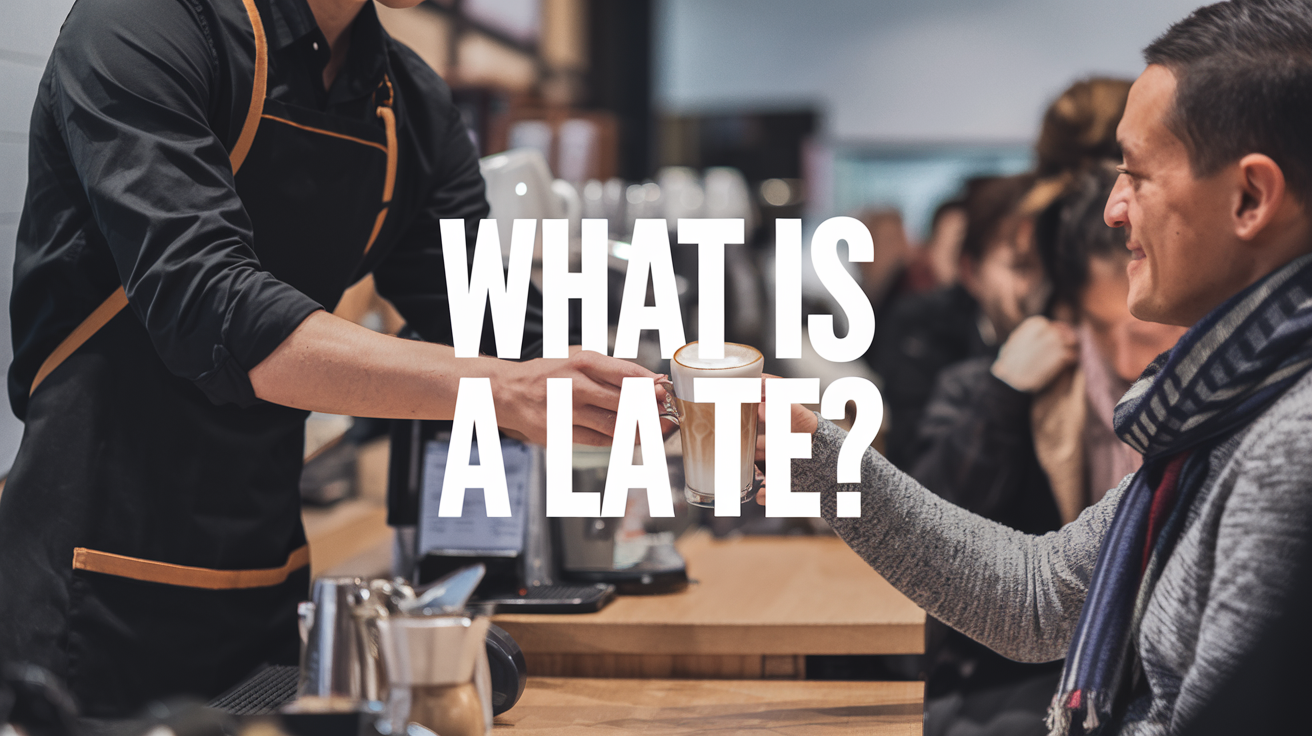Blog
What is a Cappuccino?
You love coffee, but you’re not sure what a cappuccino is. You’ve seen it on menus, but you don’t know how it’s different from other drinks. Don’t worry! This guide will clear things up.
A cappuccino is a mix of espresso, steamed milk, and milk foam. It’s named after the robes of Capuchin friars. This guide will teach you about cappuccinos and other coffee drinks. You’ll learn how they’re made and what makes them special.
Ready to become a coffee expert?
What Is A Cappuccino?
A cappuccino is a classic Italian coffee drink. It’s made with equal parts espresso, steamed milk, and milk foam.
Traditional Italian Origins
Cappuccino’s origins are firmly rooted in Italian culture. This cherished beverage first appeared in Italy during the 1930s. Its name is derived from the brown habits worn by Capuchin monks.
The contemporary cappuccino we enjoy today evolved alongside the development of espresso machines in the early 20th century. These devices allowed baristas to create the ideal blend of espresso, steamed milk, and foam.
By 1937, Venetian cafés were offering this creamy treat.
Basic Composition
A cappuccino consists of three main components: espresso, steamed milk, and milk foam. These components are equal in size. You’ll find 25 ml of espresso at the bottom. Above that, there’s 85 ml of steamed milk.
The top layer is 85 ml of milk foam. This combination creates the cappuccino’s classic taste and appearance.
The total volume of a standard cappuccino is about 180 ml. It contains 57 calories and 78.2 mg of caffeine. The milk adds 4.88 g of sugar. These figures indicate why many coffee enthusiasts enjoy cappuccinos.
They provide a balanced mix of flavour and energy boost.
Standard Size Requirements
Cappuccinos come in set sizes. A classic Italian cup holds 150-180 ml. This size lets you enjoy the perfect mix of espresso, milk, and foam. Starbucks offers a bigger 237 ml cup for their standard cappuccino.
The extra space allows for more milk and foam, giving you a fuller drink. Your local coffee shop might use different sizes, so it’s good to ask.
The right cup size matters for taste. A 180 ml cup fits 25 ml of espresso and 85 ml of steamed milk. The rest is milk froth. This balance gives you the true cappuccino flavour. Bigger cups might change how your drink tastes.
They often have more milk, making the coffee taste weaker. Choose your cup size based on how strong you like your coffee.

What Makes A Perfect Cappuccino Different From Other Coffee Drinks?
A perfect cappuccino stands out from other coffee drinks. It has a unique mix of espresso, steamed milk, and foam.
Espresso Base Requirements
Espresso forms the heart of a cappuccino. You need a rich, full-bodied shot with a golden-brown crema on top. The ideal espresso has 7-9 grams of finely ground coffee. It’s pulled for 20-30 seconds, yielding 25-30 ml of liquid.
This creates a strong base that balances well with milk. The quality of your beans matters too. Fresh, dark-roasted coffee works best for cappuccinos.
Your espresso must be hot and fresh. Serve it right away to keep its flavour. The crema should be thick and last a few minutes. If it fades fast, your shot might be off. Good espresso has a mix of sweet and bitter notes.
It shouldn’t taste burnt or sour. With the right base, you’re set to make a great cappuccino.
Milk To Coffee Ratio
The milk to coffee ratio in a cappuccino is key. A classic cappuccino has 1.4 ounces of espresso and 3.5 ounces of milk. This 1:3.56 ratio gives you a strong coffee taste with a creamy texture.
It’s different from a latte, which uses more milk. A latte has 1.4 ounces of espresso to 8.1 ounces of milk, making it milkier.
You’ll notice the difference in taste and look. A cappuccino has a thicker layer of foam – about 1.5 cm. A latte’s foam is thinner at 1.0 cm. The coffee flavour in a cappuccino stands out more due to less milk.
If you like a stronger coffee taste with a bit of milk, a cappuccino is your best bet.
Foam Characteristics
Cappuccino foam comes in two main types. Dry foam has big, airy bubbles. Velvety foam has tiny bubbles you can barely see. Baristas make foam by pouring steamed milk first. Then they add espresso and milk froth on top.
This creates a special foam that’s different from a latte’s soft, silky foam.
At home, you can make cappuccino foam too. Begin with espresso in your cup. Add steamed milk next. Top it off with milk froth. Your foam should sit on top of the drink. It should be thick enough to hold a sprinkle of cocoa powder.
Temperature Specifications
The perfect cappuccino needs milk at just the right heat. You’ll want to warm it to 55–65°C. This range brings out the milk’s natural sweetness. It also makes the foam stable and smooth.
Don’t go over 70°C, or you’ll lose the good taste. At 60°C, your cappuccino will taste its best. The foam will feel nice in your mouth too. Baristas use this trick to make top-quality drinks.

How Is A Cappuccino Made?
Making a cappuccino is an art. You’ll need an espresso machine, fresh coffee beans, and cold milk to start.
Espresso Extraction Process
Espresso extraction is key to a great cappuccino. You start with finely ground coffee beans. Pack them tightly into a filter basket. Then, force hot water through at high pressure.
This process takes about 25-30 seconds. It creates a small, strong shot of coffee with a layer of crema on top.
For a perfect cappuccino, you need a double shot of espresso. That’s 40g or 1.4 ounces. Use 20g of coffee grounds to get this amount. The ratio of coffee to water is 1:2. This gives you a rich, full-bodied base for your drink.
The crema adds a smooth texture and helps blend the milk and coffee.
Milk Steaming Technique
Milk steaming is key to a great cappuccino. You’ll need to heat the milk while making tiny bubbles. This creates microfoam, which gives the drink its smooth texture. To do it right, tilt your jug and place the steam wand just below the milk’s surface.
You’ll hear a soft hiss as air is drawn in.
Keep the wand steady and watch the milk spin. It should form a whirlpool or standing wave. This mixes the foam evenly. As you steam, the milk will grow in volume by about 50%. Stop when it’s hot to touch but not boiling.
The result? Silky, glossy milk that’s perfect for your cappuccino.
Layering Method
Layering is key to a perfect cappuccino. You start with a shot of espresso at the bottom. Then, you add steamed milk on top. Last, you spoon on a layer of milk foam. This method creates a 1-to-1 ratio of liquid to foam.
It gives the drink its classic look and feel. The layers should be clear and distinct. A good barista can make these layers look like art in the cup.
To get it right, you need skill and practice. The espresso must be fresh and hot. The milk needs just the right amount of steam. And the foam should be thick but light. When done well, you’ll see three clear parts in your cup.
Each sip will give you a mix of strong coffee and creamy milk.
Professional Barista Tips
Pro baristas use a few key techniques. They tap the milk jug on the counter to break large bubbles. This creates smooth foam. They also swirl the milk before pouring. It blends the foam and liquid milk well.
For the best taste, they extract the espresso shot right before adding milk. Fresh espresso has a rich flavour and pleasant crema.
Timing is key in cappuccino-making. Pros steam milk while the espresso brews. This keeps both components hot. They also tilt the cup when pouring milk. It helps create attractive designs on top.
Finally, they serve the drink promptly. A perfect cappuccino should be hot and fresh.

What Are The Different Types Of Cappuccino?
Cappuccinos come in many types. You can try wet, dry, iced, or flavoured ones. Want to know more? Keep reading!
Wet Cappuccino
Wet cappuccino gives you a smoother, milkier drink. It has less foam than a regular cappuccino. You’ll find a mix of one part espresso to two parts steamed milk. A thin layer of foam tops it off.
For the creamiest taste, full-fat milk works best. But you can use non-dairy milk too. Just know it might change the flavour a bit.
Want to avoid a bitter taste? Keep an eye on brewing time. Don’t let the milk get too hot. Use fresh coffee beans that you’ve stored well. These tips help you make a tasty wet cappuccino at home or enjoy one at your local café.
Dry Cappuccino
Dry cappuccinos pack a stronger coffee punch. They have more foam than milk, giving you a bolder taste. Baristas make them by adding extra air when steaming the milk. This creates a thick, airy foam that sits on top of the espresso.
You can tell it’s done right if you can wiggle the cup without spilling.
The foam in a dry cappuccino acts like a lid. It traps the heat and aroma of the espresso below. This means you get a hotter drink with more intense flavours. Coffee lovers often choose this style to really savour the espresso’s notes.
Iced Cappuccino
Iced cappuccinos provide a cool variation on the classic hot beverage. They combine espresso, cold milk, and ice for a chilled sip. Tim Hortons in Canada names their version “Iced Capps”.
These cold drinks have become popular worldwide.
Greece, Cyprus, and parts of Italy enjoy cappuccino freddo, a chilled version of cappuccino. Starbucks introduced this cold beverage to Europe in 2017. Now, you can find iced cappuccinos in numerous coffee shops during warmer seasons.
Flavoured Variations
Cappuccinos come in many tasty flavours. You can add syrups like vanilla, caramel, or hazelnut to your drink. Some shops dust cocoa or cinnamon on top for extra taste. You might even find cappuccinos with pumpkin spice or peppermint during holidays.
For a twist, try a mocha cappuccino with chocolate syrup. Or go for a nutty flavour with almond or coconut milk instead of regular milk. These fun options let you enjoy your cappuccino in new ways.
Just pick your favourite and sip away!

When Is Cappuccino Typically Served?
Cappuccino habits vary across the globe. In Italy, you’ll sip this frothy treat before 11 am, while in the UK, it’s a popular all-day drink.
Traditional Italian Customs
Italians love their coffee rituals. You’ll see locals at bars, sipping espresso quickly while standing. They don’t sit down – it’s cheaper to drink at the counter. Most Italians finish their cappuccinos by 11 am.
They believe milky drinks after lunch hurt digestion.
A standard coffee at an Italian bar costs about 1 Euro. It’s a cheap way to taste real Italian culture. You can join in this daily custom easily. Just order a “caffè” and enjoy it like the locals do.
Modern Serving Practices
Cafes now serve cappuccinos all day long. You can enjoy this drink any time you like. Many shops offer different sizes too. You might find small, medium, and large cups. Some places even add flavours like vanilla or caramel.
They often use fancy designs on top of the foam. This is called latte art.
Baristas make cappuccinos with care. They use 150 to 180 ml cups. Each drink has equal parts espresso, steamed milk, and froth. The foam can be dry or smooth. Some shops use machines to make the drinks faster.
But many still make them by hand for the best taste.
Cultural Differences
Coffee habits differ greatly around the world. In Italy, you’ll find a unique coffee culture. Italians often drink their coffee standing at the bar. It’s cheaper than sitting at a table.
A caffè at the bar costs about 1 Euro.
In the US, coffee shops are places to sit and chat. But in Italy, you drink quickly and leave. If you order a “latte” in Italy, you’ll get hot milk. Not the milky coffee drink you might expect.
These small details show how coffee customs can vary between countries.

How To Store And Serve Cappuccino?
Serve your cappuccino in a warm cup at 65°C for the best taste… Want to know more about storing and serving this coffee treat? Read on!
Optimal Temperature
The perfect cappuccino needs just the right heat. You’ll want your drink at 65°C. This temp brings out the best flavour. Milk starts to burn at 70°C, so be careful not to go too hot.
Aim for milk that’s warmed past 60°C but below 80°C – that’s when it boils. Getting this right makes your cappuccino taste great.
Your barista knows these temps by heart. They use special tools to heat the milk just right. This care makes sure you get a tasty, smooth drink every time. Good coffee shops train their staff to hit these marks.
It’s part of what makes a pro cappuccino so good.
Cup Selection
Cup shape affects your cappuccino experience. Wide cups keep foam stable and look great. A 5-6 ounce (150-180 ml) cup is perfect for a classic cappuccino. Insulated cups help your drink stay hot longer.
Choose your cup wisely to enjoy your cappuccino fully. The right cup size and shape can make your coffee taste better and look nicer. It’s a small detail that makes a big difference in your coffee time.
Presentation Guidelines
Serve your cappuccino in a 180 ml cup. This size lets you enjoy the perfect mix of espresso, milk, and foam. Top it off with a dusting of cocoa powder or cinnamon for a classic look.
You can also add flavoured syrups if you like. Make sure the foam is thick and creamy. It should sit proudly on top of the milk and coffee layers.
Your cappuccino should have clear layers when served. The bottom layer is 25 ml of rich espresso. Next comes 85 ml of steamed milk. The top layer is a thick, velvety foam. This creates the drink’s signature look and feel.
Serve it right away while it’s hot and fresh for the best taste.
Storage Recommendations
Keep your coffee fresh by storing it right. Put it in a dark, cool cupboard away from heat and light. Use an airtight container to stop air getting in. This helps your coffee stay tasty for longer.
For the best flavour, buy small amounts of coffee often. Grind the beans just before you brew. If you need to keep coffee for longer, freeze whole beans in airtight bags. They’ll stay good for up to a month this way.
Conclusion
You’ve learned the ins and outs of cappuccino. It’s a tasty mix of espresso, steamed milk, and foam. You now know how it differs from other coffee drinks. You can make one at home or order like a pro at cafes.
Why not try a cappuccino today and taste the magic?
FAQs
1. What’s a cappuccino?
A cappuccino is a popular coffee drink. It’s made with espresso, steamed milk, and a thick layer of foam on top. Often, it has a dusting of chocolate. It’s served in a smaller cup than a latte.
2. How’s a cappuccino different from a latte?
The main difference is the ratio of coffee to milk. A cappuccino has more foam and less milk than a latte. Lattes have more steamed milk and just a thin layer of foam on top. Both start with espresso.
3. What’s a macchiato?
A macchiato is a type of coffee with just a small amount of milk. It’s stronger than a cappuccino or latte. There are two types: caffè macchiato and latte macchiato. The first has more coffee, the second more milk.
4. When did cappuccinos come to the UK?
Cappuccinos first came to Europe and America in the 1900s. They became popular in UK coffee bars in the 1950s. Now, they’re a common choice in coffee shops across the country.
5. How do I make a cappuccino at home?
To make a cappuccino, you need an espresso machine. First, brew a shot of espresso. Then steam milk until it’s frothy. Pour the milk over the espresso, holding back the foam. Top with the foam. You can add cocoa powder if you like.
6. What’s a flat white?
A flat white is like a small latte. It has espresso and steamed milk, but less foam than a cappuccino. It’s popular in Australia and New Zealand. The milk is ‘microfoam’, which makes it smoother than other coffee drinks.


